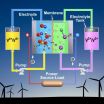(Press-News.org) COLUMBUS, Ohio – In a first-of-its-kind study, researchers found that mobile media technologies such as smart phones aren't taking people away from relying on traditional media sources such as newspapers or television.
Instead, mobile media are filling the spaces in people's daily routine in which other media sources are either unavailable or inconvenient to use.
That suggests mobile media use is taking a different path to popularity than did technologies like television, said John Dimmick, lead author of the study and professor of communication at Ohio State University.
"Typically, what happens with new media is that they compete with and displace older media to a certain extent, like television did with radio," Dimmick said.
"But at least early in its development, mobile media isn't taking us away from older media – it has its own separate niche."
Dimmick conducted the study with Gregory Hoplamazian, a graduate student at Ohio State, and John Christian Feaster of Rowan University in New Jersey. The results appear in the current issue of the journal New Media & Society.
Dimmick noted that the data in this study was collected in 2007, the year that the first Apple iPhone was released. The success of the iPhone may mean that mobile media has started to make inroads into the use of other media technologies, Dimmick said, but we won't know for sure until new studies are completed.
This study involved 166 participants who agreed to keep a time-space diary of their media use over the course of a day. During the day assigned to them, they recorded where and when they accessed a variety of media technologies, including mobile media technologies such as smart phones, as well as television, newspaper, desktop and laptop computers, radio and others.
The participants recorded whenever they accessed news, sports or weather content, on any technology at any place and time.
All of the participants, who were ages 19 to 68, were selected by a survey firm on behalf of the researchers. The researchers specifically excluded full-time students to ensure that all participants had a daily routine, Dimmick said. This was necessary so the researchers could learn how mobile media are used to access news by people with time and space constraints, such as full-time jobs.
Using the data from the diaries, the researchers analyzed when and where participants were most likely to use different technologies to access news content.
The participants recorded a total of 1,843 media sessions – a period of time when they used a single medium to access news, sports or weather content.
Overall, mobile media was still a relatively minor player in the way people accessed news – it accounted for only about 7 percent of all media sessions, Dimmick said.
Computers were the most popular method for accessing news, with about 24 percent of all media sessions occurring on desktops and 15 percent occurring on laptops. Television accounted for about 29 percent of all media sessions. Newspapers and radio each accounted for about 9 percent of sessions.
But each form of technology had its own niche where it was particularly popular, the results showed.
For example, mobile media technologies were clearly the preferred method of accessing news during the workday when people were on the move.
But television remained king for news access at home during the evening and night. The clearest niche for newspapers appeared to be at home during the morning. Computers, both desktop and laptop, were most often used to access news at work. Participants most often used radio in their cars during the morning and evening commutes.
"The legacy media including newspapers, radio and television are still popular at the times and places where they have always been popular," Dimmick said.
"Mobile media is filling in the spaces and times where people are on the move, away from their offices and homes, such as when they are in the line at the supermarket or eating lunch at a restaurant."
###
The study was supported by a grant from the Knight Foundation and the Harvard Center for the Press and Public Policy.
Contact: John Dimmick, (614) 292-0168; Dimmick.1@osu.edu
Written by Jeff Grabmeier, (614) 292-8457; Grabmeier.1@osu.edu
END
UCLA researchers have identified a new biomarker that could help them track how effectively the immune system is able to clear the brain of amyloid beta, which forms the plaques considered one of the hallmarks of Alzheimer's disease.
The pilot study, currently published online in the Journal of Alzheimer's Disease, demonstrates how the immune gene MGAT3, which is essential in clearing amyloid beta, is expressed differently in different Alzheimer's patients. The finding may be useful in providing more highly individualized disease prognoses in the future.
It may also ...
Consumers estimate they'll spend more time enjoying activities when the tasks are broken down into components, according to a new study in the Journal of Consumer Research. But using the same process for an unpleasant event decreases time estimates.
"It has been well established that predicted consumption time plays a central role in consumers' evaluations and purchase decisions," write authors Claire I. Tsai and Min Zhao (both University of Toronto). "If consumers foresee spending a lot of time using a product or service (such as gym membership or cable TV), they are ...
Of around seven land vertebrate species whose survival in the wild is threatened one is also kept in captivity. These and other data on the protection of species in zoos and aquaria have now been revealed by scientists at the Max Planck Institute for Demographic Research (MPIDR) in Rostock. Writing in the journal Science, the team of researchers and the International Species Information System (ISIS) advocate the establishment of targeted captive breeding programmes to supplement the protection of animals in the wild. To do this, zoos should team up in networks and shelter ...
Researchers have shown for the first time that stem cells injected into enlarged hearts reduced heart size, reduced scar tissue and improved function to injured heart areas, according to a small trial published in Circulation Research: Journal of the American Heart Association.
Researchers said that while this research is in the early stages, the findings are promising for the more than five million Americans who have enlarged hearts due to damage sustained from heart attacks. These patients can suffer premature death, have major disability and experience frequent hospitalizations. ...
RICHLAND, Wash. – Though considered a promising large-scale energy storage device, the vanadium redox battery's use has been limited by its inability to work well in a wide range of temperatures and its high cost. But new research indicates that modifying the battery's electrolyte solution significantly improves its performance. So much so that the upgraded battery could improve the electric grid's reliability and help connect more wind turbines and solar panels to the grid.
In a paper published by the journal Advanced Energy Materials, researchers at the Department of ...
SOUTH AFRICA—The common fig is a subtropical, deciduous fruit tree grown in most Mediterranean-type climates. Although some believe that figs may be the oldest cultivated fruit species on earth, global expansion of fig crops has been hindered by the narrow research base pertaining to production practices and the limited number of fig cultivars currently available. Recently, three black figs were established in the Mediterranean-type climate of Western Cape Province of South Africa to provide fruit for fresh markets throughout South Africa and Europe.
Hein J. Gerber, Willem ...
TOLEDO, OH—In parts of the United States where ornamental and vegetable plants are produced in greenhouses during cold seasons, heating costs are second only to labor costs for greenhouse operators. Greenhouse growers are faced with important management decisions that rely on understanding how temperature settings, heating systems, fuel types, and construction decisions influence their heating costs. To address the lack of user-friendly computer programs currently available for calculating heating costs in greenhouse operations, scientists have created a state-of-the-art ...
BOSSIER CITY, LA—Perlite, a processed volcanic mineral, is widely used as a component of soilless growing mixes. Lightweight, sterile, and easy to use, perlite is popular with greenhouse growers. But because salt and pathogen buildup can occur when perlite is reused, it must be replaced every year or two to minimize the risk of crop failure. The cost of disposing of old material and replacing it with new perlite can be significant and often prohibitive for smaller greenhouse operations. Hanna Y. Hanna, a researcher at Louisiana State University Agricultural Center's Red ...
AMES, IA—Recognizing the need for university students to develop problem-solving skills they will need in their careers, educators are looking to student-centered, problem-based learning strategies. Problem-based learning (PBL) experiences have been shown to promote higher-order thinking skills in students, but, for faculty, implementing and assessing problem-based activities often means a substantial time investment. Iowa State University professor Ann Marie VanDerZanden and graduate student Tigon Woline published a study in HortTechnology that reported on an innovative ...
Systems biology is a holistic approach to the study of how a living organism emerges from the interactions of the individual elements that make up its constituent cells. Embracing a broad range of disciplines, this field of science that is just beginning to come into public prominence holds promise for advances in a number of important areas, including safer, more effective pharmaceuticals, improved environmental remediation, and clean, green, sustainable energy. However, the most profound impact of systems biology, according to one of its foremost practitioners, is that ...




